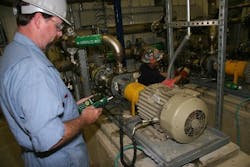The challenge for energy producers to supply continuous, uninterrupted power to customers is constant. Forced outages, which usually occur because of unexpected component failures or systemic problems, can prove costly to the power supplier and undermine its effort to attract and maintain satisfied customers. To reduce the frequency and duration of forced outages, Calpine Corp. is implementing a comprehensive predictive maintenance (PdM) program.
Founded in 1984 and headquartered in San Jose, Calif., Calpine is one of North America's largest power generation companies. In recent years, the company has evolved from solely a leading developer of power plants to a major power-plant operator and service provider. As an electricity wholesaler, Calpine provides electricity to a variety of customers, including electric utilities, industrial manufacturers, municipalities and government institutions. Using two types of fuel -- natural gas and geothermal steam -- to produce electricity, Calpine has the capacity to generate more than 26,000 megawatts from its 92 energy centers in 21 states. Additionally, Calpine operates plants in Canada and the United Kingdom.
Downtime at $11,000/hour
To meet the growing demand for electricity across North America, Calpine continues to increase production while instituting process changes to maximize existing capacity. Our business strategy is centered on expanding generating capacity and optimizing production capability, thereby increasing revenue and maximizing profits by reducing expenses.
In the power generation industry, as well as the Calpine Predictive Maintenance Department, downtime expense is calculated in cost-avoidance terms based on the profit from generating a megawatt-hour of electricity plus the avoided cost of repair. Depending on the plant and the spark spread (a theoretical margin represented by the difference between the price of electricity sold and the price of the fuel used to generate it), the profit for a megawatt-hour varies drastically -- ranging from $5 to more than $50 per hour. For example, at a 560-megawatt Calpine plant in California, the cost avoidance is calculated based on an average of $21 per megawatt-hour. Therefore, average downtime at this particular plant could cost $11,000 an hour ($264,000 a day) or more.
With this much potential profit at stake, maintaining energy production, reducing forced outages (caused by unplanned shutdowns or equipment failure), and avoiding generator deratings (when a unit fails to deliver power at its rated capacity) are top priorities for management and employees alike.
Strategy based on ROI
Recognizing that rates always will fluctuate based on changes in market and supply demands, we began to focus on controlling costs: reducing forced outages and streamlining maintenance and repair costs. In 2002, only a handful of Calpine’s plants routinely practiced PdM techniques, with each conducting its own PdM activities in a nonstandardized manner. As a result, no uniform technology or strategy was used, sharing of best practices and successes was limited, and each plant handled equipment failures in its own unique manner.
After reviewing the options and potential strategies for meeting uptime, reliability and profitability goals, senior management decided to develop and begin implementing a comprehensive PdM program across the Calpine fleet of plants. Committed to providing consistent power to our customers, our primary goal was to reduce forced deratings and outages, both of which are catastrophic events. Simply stated, we can’t allow our customers to be without power. To make sure that doesn’t happen, we needed a uniform PdM program that could readily be implemented at the majority of our plants.
We reviewed the PdM programs offered by three maintenance solution providers for critical elements including user-friendly interfaces; operating system compatibility; integration with other PdM data; the ability to interface and share information with other programs, such as Maximo CMMS; open database structure/interoperability with other Calpine systems and future development directions.
Rolled out to the individual plants in late 2002, the new PdM program consisted of a variety of proactive tools and techniques, including condition-monitoring hardware and software from Rockwell Automation. The program was designed to help maximize return on investment and prevent unplanned downtime. By implementing common procedures and practices among the various plants, Calpine is to share experiences and documented successes, which will help drive further efficiencies and cost savings across plants. Cost savings also resulted from implementing an enterprise-networked system.
The per-plant savings achieved is approximately $15,000. Sixty-six Calpine plants are now set up in the Enshare system, which adds up to nearly $1 million in cost savings.
During the selection process, we found that only one software package, Entek Emonitor Enterprise software from Rockwell Automation, met our needs for supporting condition-based maintenance data as well as for sharing information across our disparate sites. With database storage capabilities, the Emonitor Enterprise system serves as a central repository for the information gathered from the power plants enrolled in the program. The system allows engineers and technicians to access any site’s database to examine equipment life-cycle trends and determine if common failures occur on specific types or models of equipment. Additionally, we are using the Emonitor Enterprise system to help pinpoint repetitive equipment failures at the same plant or at multiple plants.
Focus on critical equipment
At each location, on-site maintenance personnel identify the equipment where vibration data will be collected (Figure 1). Vibration analysis is conducted on equipment deemed critical to maintaining production, including gas turbines, steam turbines, cooling fans and critical oil and water pumps.
To determine if a piece of equipment is classified as critical, we look at two key criteria: first, it has the potential to cause either a forced outage or a generator derating; or second, the repair/replace cost of the equipment is at a level that’s high enough to justify condition monitoring. Then, we may have a redundant or backup piece of equipment in place to avoid interruptions in production in the event the primary equipment needs to be shut down or repaired.
We collect data from approximately 60 machines at each plant with roughly 10 data sets collected from each machine. This computes to approximately 600 points of data collected at each of the 47 plants that have enrolled in the PdM program so far. As appropriate, some critical equipment is monitored using complementary, online motor analysis, off-line motor analysis, lubrication oil analysis, transformer oil analysis and infrared thermography technologies.
As an internal service provider, my team of eight PdM engineers and technicians perform different PdM activities at each of the plants, including vibration analysis, online motor analysis, off-line motor analysis, as well as infrared thermography and lubrication and transformer oil analysis. We collect vibration readings monthly using Entek Enpac handheld data collectors from Rockwell Automation (Figure 2).
Once gathered, we download the data from the handheld data collectors directly into Emonitor Enterprise software (Figure 3). The software processes the data, compares it against preset limits, and provides advance warning of equipment abnormalities and potential points of failure. With this information, the team can analyze potential problems and recommend corrective actions before performance is affected.
Cost avoidance key to acceptance
One of the challenges we faced with the program was getting the individual Calpine plants on board with the PdM program. In particular, it was challenging to justify and demonstrate the value of PdM because of the difficulty in measuring and documenting the cost savings of potential events that were ultimately prevented and never occurred.
Still, we’ve been able to record some impressive examples of cost avoidance. In one instance, we used the PdM tools to identify an impending water pump failure. The problem was traced to a damaged bearing on a 2,000-hp motor. From a cost-avoidance perspective, we opted to remove the motor and have the bearing replaced, resulting in minor downtime and minimal repair costs. By taking a proactive approach in this case, Calpine avoided an expensive motor replacement and unplanned downtime costs, which would have totaled an estimated $370,000 in this one occurrence. My team and I identified and corrected four similar problems, each with an average cost avoidance of approximately $200,000.
To date, the 47 of our 92 plants enrolled in the PdM program take approximately 28,000 points of data from 2,800 pieces of equipment. Located throughout the U.S., these sites have recorded tremendous results from the program. In the first half of 2003, we estimate that the program helped avoid downtime and repair costs exceeding $1 million, almost doubling the year-end goal of $600,000. In 2004, cost avoidance at the plants directly related to application of PdM techniques exceeded $1.5 million.
Documentation improved versus 2003, but all cases were not documented. From January to June of 2005, documented cost avoidance has exceeded $1.5 million.
Overall, the maintenance program has enabled Calpine to maximize system reliability by identifying and correcting potential problems before a forced outage occurs or production is interrupted; now Calpine can carefully plan and time equipment repair and replacement to avoid any sudden process interruptions.
Kevin Nordenstrom, predictive maintenance engineering manager, Calpine Corp., can be reached at [email protected].



